Michelle and David Weisbord, then living near Philadelphia, were elated when their daughter Ella was born in April 2014, weighing 5 pounds and 13 ounces.
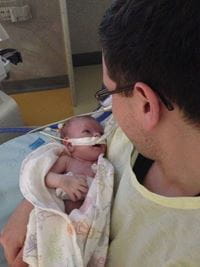 When she was only 10 days old, the Weisbords noticed that Ella felt “clammy” and was sleeping a lot. They called their pediatrician who told them to go to the nearest Emergency Department (ED). When they arrived at that ED, Ella was hypothermic, running a temperature of about 95 degrees. She had several seizures and needed a breathing tube. The adult hospital decided to transport Ella to the nearby children’s hospital because they not have the proper equipment to safely intubate a less-than-two-week-old baby.
When she was only 10 days old, the Weisbords noticed that Ella felt “clammy” and was sleeping a lot. They called their pediatrician who told them to go to the nearest Emergency Department (ED). When they arrived at that ED, Ella was hypothermic, running a temperature of about 95 degrees. She had several seizures and needed a breathing tube. The adult hospital decided to transport Ella to the nearby children’s hospital because they not have the proper equipment to safely intubate a less-than-two-week-old baby.
Since Ella was relatively stable, the children’s hospital sent an ambulance, a respiratory therapist, and a doctor to the adult hospital to facilitate the half hour transfer.
After doctors and staff ran many tests, they diagnosed Ella with E. coli (bacterial) neonatal meningitis.
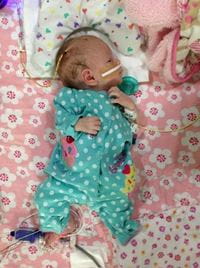 Meningitis is an inflammation or swelling of the protective membranes covering the brain and spinal cord, usually due to viral infection, but occasionally due to bacterial or fungal infections. E. coli is the second most common bacterial cause of neonatal meningitis. 20 to 50% of newborns who survive E. coli meningitis develop serious brain and nerve problems, such as an accumulation of extra fluid in the normal open spaces within the brain (hydrocephalus), hearing loss, and intellectual disability.
Meningitis is an inflammation or swelling of the protective membranes covering the brain and spinal cord, usually due to viral infection, but occasionally due to bacterial or fungal infections. E. coli is the second most common bacterial cause of neonatal meningitis. 20 to 50% of newborns who survive E. coli meningitis develop serious brain and nerve problems, such as an accumulation of extra fluid in the normal open spaces within the brain (hydrocephalus), hearing loss, and intellectual disability.
Ella was eventually intubated, stabilized, and administered intravenous antibiotics to fight the infection. However, her head had become enlarged due to hydrocephalus.
On her second day in the hospital, Ella had an external ventricular drain (EVD) put in to try to drain some of the extra cerebrospinal fluid (CSF) from her brain. Doctors were continually testing the fluid from the drain to see if she had cleared the infection to no avail. Eventually, Ella’s doctors explained, the EVD would need to be removed.
Her doctors were also having a tough time getting the infection to go away. They told the Weisbords there was another option to consider to clear the infection – Intrathecal Gentamicin. This would involve direct administration of an antibiotic to her brain via the EVD. While this comes with a greater risk of hearing loss, it was decided that this was the best treatment course for Ella.
 This treatment successfully cleared the infection, and Ella remained in the neonatal intensive care unit (NICU) while she recovered. After about a month, she had her EVD removed and a ventriculoperitoneal (VP) shunt put in. This shunt would continue draining the additional CSF from Ella’s brain and move it via a catheter or thin plastic tube under the skin into her belly region where the extra fluid is absorbed into the bloodstream.
This treatment successfully cleared the infection, and Ella remained in the neonatal intensive care unit (NICU) while she recovered. After about a month, she had her EVD removed and a ventriculoperitoneal (VP) shunt put in. This shunt would continue draining the additional CSF from Ella’s brain and move it via a catheter or thin plastic tube under the skin into her belly region where the extra fluid is absorbed into the bloodstream.
After another month, the Weisbords were finally able to return home.
A New Normal
Once home, Ella and her family began adjusting to their new normal of navigating Ella’s condition and ensuring that her shunt stayed in place and functioned properly to keep her hydrocephalus under control.
According to Ella’s mom, Michelle, Ella will always require a shunt because of the brain damage that was caused by the initial infection.
“The shunt is essentially coiled up in her belly and grows as she grows,” she said.
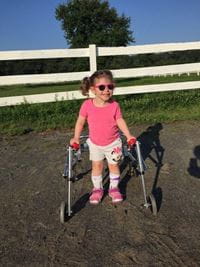 Another complicating factor is the form of hydrocephalus that Ella has, which is known as loculated hydrocephalus. Loculated hydrocephalus is a particularly complex condition in which different non-communicating compartments form within the ventricular system. This condition would eventually lead Ella to require multiple surgeries.
Another complicating factor is the form of hydrocephalus that Ella has, which is known as loculated hydrocephalus. Loculated hydrocephalus is a particularly complex condition in which different non-communicating compartments form within the ventricular system. This condition would eventually lead Ella to require multiple surgeries.
As Michelle explains it, “These loculations are build ups of scar tissue in the brain. And they can cause the shunt to clog or they can close off a ventricle, which won’t allow it to drain even though the shunt may be working properly.”
Michelle and David always kept a close eye on Ella for signs of a shunt malfunction which include vomiting, lethargy, and fever.
These complications would lead to the Weisbords frequenting the hospital beginning just two weeks after their return home for management of Ella’s shunt. In her first four years of life, Ella would require 10 surgeries in Philadelphia.
A Cross-State Move for the Weisbords and a New Medical Home at UPMC Children’s
In 2018, when Ella was around 4 years old, her father, David received a job opportunity in Pittsburgh – across the state from their home near Philadelphia. While considering the move, the Weisbords needed to feel confident in the medical care available to Ella in the new location.
“Before moving, we met with doctors at UPMC Children’s and getting to know them and the level of care that Ella would receive there really made us feel more comfortable about coming out [to Pittsburgh],” said Michelle. “We wouldn’t have felt confident making the decision to move without feeling confident that Ella would be in good hands in Pittsburgh. That was our number one priority.”
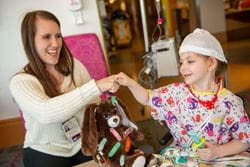 That year, the Weisbords made the move – purchasing a home in close proximity to Children’s and transferring Ella’s care.
That year, the Weisbords made the move – purchasing a home in close proximity to Children’s and transferring Ella’s care.
Since moving to Pittsburgh, Ella has had another 19 surgeries at Children’s. She regularly meets with specialists across the hospital to manage her care from neurosurgery and neurology to endocrinology, ophthalmology, gastroenterology, and more for various complications that arise.
“The Complex Care team at Children’s is truly amazing,” says Michelle. “They are always there to help us navigate what’s going on. They help us determine is it the shunt that’s the issue? Which department do we need to see? All of our doctors and surgeons have been fantastic.”
Michelle says they were especially helpful through the COVID-19 pandemic as many of the symptoms of infection from COVID-19 mirrored the symptoms of a shunt malfunction or infection.
“They were so helpful in answering all of our calls trying to figure out, ‘Is this COVID or something with the shunt?’ They would help calm us down and make sure we were on the right path and would refer us to different doctors if it was needed. We so appreciated that,” said Michelle.
“A Trooper and a Champ”
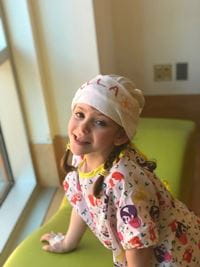 Today, Ella has overcome much more than your average 9-year-old in her short life.
Today, Ella has overcome much more than your average 9-year-old in her short life.
Michelle explains that while Ella has experienced some brain damage from the initial infection in infancy, she has made great strides.
“She went from not necessarily being able to hold her head up to now being able to walk on her own. It took years for her to meet that milestone of being able to walk, and she still requires a wheelchair for long distances, but it’s remarkable. She has had a lot of therapies over the years but she has been a champ through it all,” says Michelle.
For the past two years, Ella attended the Children’s Institute in Pittsburgh for her schooling and this year she is attending their local public school. Michelle says that at school Ella is “super social and chatty” and has done great.
Through all of the ups and downs, Ella has always maintained a positive and sunny demeanor.
“She’s always smiling and happy. It’s not even surprising to see her singing as she’s going into the operating room for yet another surgery. She doesn’t need any medicine or anything to calm her down. She doesn’t cry with blood or IVs. She’s a real trooper.”
Teaming Up for Miracle League
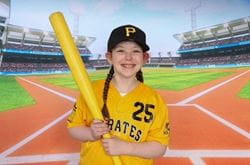 Ella loves being involved in various activities, from playing with her dolls to bocce ball through the Special Olympics. But her favorite activity is baseball. So much so that she participates in the Miracle League of Southwestern PA and the Miracle League of the South Hills, PA.
Ella loves being involved in various activities, from playing with her dolls to bocce ball through the Special Olympics. But her favorite activity is baseball. So much so that she participates in the Miracle League of Southwestern PA and the Miracle League of the South Hills, PA.
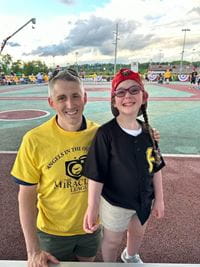 This year Ella was excited to be invited to participate in the All-Star Weekend Pirates Training Camp and the All Star Game hosted by the Miracle League of Southwestern PA at Pirates Charities Miracle League Field in Cranberry.
This year Ella was excited to be invited to participate in the All-Star Weekend Pirates Training Camp and the All Star Game hosted by the Miracle League of Southwestern PA at Pirates Charities Miracle League Field in Cranberry.
“During the training camp she received an amazing jersey, and we requested the number 29… Ella has battled through 29 brain surgeries so far, let’s celebrate that strength!” said David.
Then the Weisbords had the thought to ask Ella’s neurosurgeon, Dr. Taylor Abel if he was interested in being Ella’s buddy for the game. Dr. Abel said yes and the two had a great time “chatting (and playing baseball) outside of the hospital for once.”
An Expert Team in Ella’s Corner for the Journey Ahead
 While Ella’s conditions may always require close management, Michelle says she is grateful to have a team like the one at Children’s whose number one priority is ensuring Ella receives the best possible care.
While Ella’s conditions may always require close management, Michelle says she is grateful to have a team like the one at Children’s whose number one priority is ensuring Ella receives the best possible care.
The Weisbords are also hopeful for all of the research being done around hydrocephalus to hopefully bring about improvements in technology and treatment. They know that their team at Children’s is on the front line of those developments and are continually looking for new and better way to manage Ella’s hydrocephalus.
“We don’t know what her life will be like, she may have other disabilities as she grows,” says Michelle. “But we’re proud of how far she has already come and glad to have Children’s on our team.”
Ella’s treatment and results may not be representative of similar cases.









